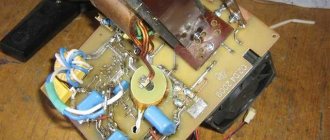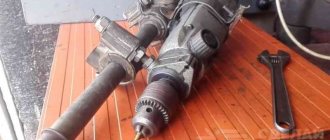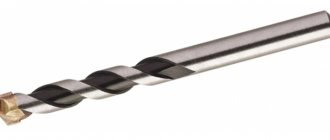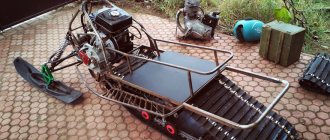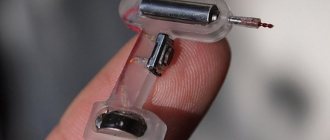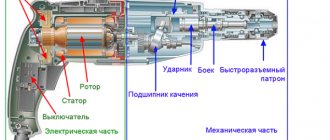Hello! There are many people on this resource who work in electronics and make their own printed circuit boards. And each of them will say that drilling printed circuit boards is a pain. Small holes have to be drilled in hundreds and everyone solves this problem for themselves. In this article, I would like to present to your attention an open-source project for a drilling machine that anyone can assemble themselves and will not need to look for CD drives or object tables for a microscope.
Description of design
The design is based on a fairly powerful 12-volt motor from China.
Included with the engine, they also sell a cartridge, a wrench and a dozen drills of different diameters. Most hams simply buy these motors and drill the boards while holding the tool in their hands. I decided to go further and, based on it, make a full-fledged machine for similar engines with open drawings for independent production.
To move the motor linearly, I decided to use 8mm diameter polished shafts and linear bearings. This makes it possible to minimize backlash in the most critical place. These rollers can be found in old printers or purchased. Linear bearings are also widely used and available in 3D printers.
The main frame is made of 5mm thick plywood. I chose plywood because it is very cheap. Both the material and the cutting itself. On the other hand, nothing prevents (if possible) from simply cutting out all the same parts from steel or plexiglass. Some small parts with complex shapes are 3D printed.
To lift the engine to its original position, two ordinary rubber bands were used. In the upper position, the motor switches itself off using a microswitch.
On the reverse side I provided a place to store the key and a small case for drills. The grooves in it have different depths, which makes it convenient to store drills with different diameters.
But it’s easier to see all this once on video:
There is a slight inaccuracy on it. At that moment I came across a defective engine. In fact, from 12V they consume 0.2-0.3A at idle, and not two, as they say in the video.
What should it consist of?
A basic unit can be made from an ordinary drill. You can add additional devices to it - for example, a milling unit. But each machine must consist of several required elements: a drill, a countersink, a reamer and a tap.
There are many types of drilling units in industry - semi-automatic, spindle, vertical and others. In everyday life, the so-called mini-additive unit with a modest set of tasks is most often used. Before you make a homemade drilling machine at home, you need to understand the functions, basic elements and general operating principles of this type of mechanism.
By function, the most popular devices are spindle machines, the main function of which is to transmit rotational motion to the workpieces. In second place in popularity are devices for horizontal and radial drilling. An apparatus for boring parts is also common. With such functional diversity, drilling equipment is generally classified as a device for universal use.
But with this freedom there are a number of mandatory components, without which there are no drilling machines in principle:
- bed;
- steering rack;
- engine.
Parts for assembly
- Engine with chuck and collet. On the one hand, a jaw chuck is very convenient, but on the other hand, it is much more massive than a collet clamp, that is, it is often subject to beats and very often they have to be additionally balanced.
- Plywood parts. A link to files for laser cutting in dwg format (prepared in NanoCAD) can be downloaded at the end of the article. You just need to find a company that deals with laser cutting of materials and give them the downloaded file. I would like to note separately that the thickness of the plywood may vary from case to case. I come across sheets that are a little thinner than 5mm, so I made the grooves 4.8mm each.
- 3D printed parts. A link to files for printing parts in stl format can also be found at the end of the article
- Polished shafts with a diameter of 8mm and a length of 75mm - 2 pcs. Here is a link to the seller with the lowest price for 1m that I saw
- Linear bearings 8mm LM8UU - 2 pcs.
- Microswitch KMSW-14
- Screw M2x16 - 2 pcs.
- Screw M3x40 h/w – 5 pcs.
- Screw M3x35 slot - 1 pc.
- Screw M3x30 h/w – 8 pcs.
- Screw M3x30 h/w with countersunk head - 1 pc.
- Screw M3x20 h/w - 2 pcs.
- Screw M3x14 h/w - 11pcs
- Screw M4x60 slot - 1 pc.
- Bolt M8x80 - 1 piece
- Nut M2 - 2 pcs.
- M3 square nut – 11pcs
- Nut M3 – 13pcs
- M3 nut with nylon ring - 1 pc.
- Nut M4 - 2 pcs.
- M4 square nut – 1 piece
- M8 nut – 1 piece
- Washer M2 - 4 pcs
- Washer M3 – 10pcs
- M3 washer enlarged - 26 pcs.
- M3 locking washer – 17 pcs.
- M4 washer - 2 pcs.
- M8 washer - 2 pcs.
- M8 locking washer – 1 piece
- Set of installation wires
- Heat shrink tube set
- Clamps 2.5 x 50mm - 6 pcs
List of components
Here is a complete list of everything needed for assembly:
- Printed circuit board (link to manufacturing files at the end of the article)
- U1 - MC34063AD, switching regulator, SOIC-8
- U2 - LM358, operational amplifier, SOIC-8
- U3 - L78L09, stabilizer, SOT-89
- D1,D3 - SS14, Schottky diode, SMA - 2 pcs
- D2 - LL4148, rectifier diode, MiniMELF
- C1 - capacitor, 10uF, 50V, 1210
- C2 - capacitor, 3.3nF, 1206
- C3, C4 - capacitor, 4.7 µF, 1206 - 2 pcs
- C5 - capacitor, 22uF, 1206
- R1-R3,R7,R9,R11 - 1 Ohm resistor, 1206 - 6 pcs.
- R4, R10 - resistor 22 kOhm, 1206 - 2 pcs.
- R5 - 1kOhm resistor, 1206
- R6 - resistor 10-27 kOhm, 1206. The resistance depends on the rated voltage of the motor used. 12V - 10kOhm, 24V - 18kOhm, 27V - 22kOhm, 36V - 27kOhm
- R8 - resistor 390 Ohm, 1206
- RV1, RV2 - subscript resistor, 15 kOhm, type 3224W-1-153 - 2 pcs.
- XS1 - terminal, 2 pins, pitch 3.81mm
We also made a limiter ring on a 3D printer for easy installation on the engine. The download link for the STL file is at the end of the article.
Assembly
The whole process is shown in detail in the video:
If you follow exactly this sequence of actions, then assembling the machine will be very simple.
This is what a complete set of all components for assembly looks like
In addition to them, assembly will require a simple hand tool. Screwdrivers, hex keys, pliers, wire cutters, etc.
Before starting to assemble the machine, it is advisable to process the printed parts. Remove possible sagging, supports, and also go through all holes with a drill of the appropriate diameter. Plywood parts along the cut line may become stained with smoke. They can also be sanded with sandpaper.
Once all the parts are prepared, it's easier to start by installing the linear bearings. They creep inside the printed parts and are screwed to the side walls:
Next, the handle with gear is installed. The shaft is inserted into a large hole, the base of the handle is installed on it and the whole thing is tightened with an 8mm bolt. The handle itself is an M4 screw:
Now you can assemble the plywood base. First, the side walls are installed on the base, and then the vertical wall is inserted. There is also an additional printed piece at the top that defines the width at the top. When driving screws into plywood, do not use too much force.
It is necessary to make a countersink in the table on the front hole so that the head screw does not interfere with drilling the board. A printed fastener is also installed at the end.
Now you can begin assembling the engine block. It is pressed with two parts and four screws to the movable base. When installing it, you must ensure that the ventilation holes remain open. It is secured to the base using clamps. First, the shaft is threaded into the bearing, and then clamps are snapped onto it. Also install an M3x35 screw, which in the future will press the microswitch.
The microswitch is installed on the slot with a button towards the engine. Its position can be calibrated later.
The rubber bands are placed on the bottom of the engine and threaded through to the “horns”. Their tension must be adjusted so that the engine rises to the very end.
Now you can solder all the wires. There are holes on the engine block and next to the microswitch for clamps to secure the wire. This wire can also be routed inside the machine and brought out from the back. Make sure you solder the wires on the microswitch to the normally closed contacts.
All that remains is to install the pencil case for the drills. The top cover must be clamped firmly, and the bottom cover must be tightened very loosely, using a nut with a nylon insert for this.
This completes the assembly!
DIY drilling machine
What to do if you don’t have a drilling machine for printed circuit boards at home? Of course, it’s expensive to buy, and it happens that the machine is not needed for frequent use. I offer you 2 simple ideas for making your own drilling machine with your own hands. The first option is very simple; to make it we will need an electric motor from cassette recorders. Remember these? Such motors can be removed from any Chinese or Soviet-made tape recorder.
They look something like this:
So, we have an electric motor, we also need a drill of the required diameter, usually 0.7-1 mm, we need to take thin paste from a ballpoint pen, a thin thread of 10 centimeters, scissors and instant glue.
Is everything ready? Let's start collecting.
We take the scribbled paste from a ballpoint pen (you can use a new one) and cut off 15 mm, then we need to put it on the motor shaft a little less than half (6-7 mm). Then remove it with a screwdriver or tweezers and put it aside (although you don’t have to remove it).
We take a drill, wind a thread on it turn to turn in 2 layers, below is the photo:
Holding the end of the thread (so as not to unwind), apply a drop of second glue and quickly push the drill into the tube. If you hesitate, the glue will harden.
Here's what we got:
If the drill rotates crookedly, you simply bend the paste in the desired direction until the drill is centered, and you can start drilling your board
Second version of the drilling machine
Now I’ll tell you about the second version of the drilling machine, the one I use. Making it will be a little more difficult. I will not give detailed drawings with dimensions, because... the machine was assembled from what we have, let the article be for informational purposes only, but I will still describe the machine in photographs and schematically. You can try to assemble a similar machine for yourself using my drawings. This machine looks like this:
It is built on a lever mechanism, when pressed, the motor and the drill are lowered, and if the lever is released, the motor rises up again.
Here is a photo of the mechanism itself:
The lifting and lowering part is made of sheet metal, the sheet is cut to the desired shape, bent and holes are drilled. Instead of the bent rod shown in the photo, you can use something similar, for example, replace it with two long M4 screws with a thread at the end.
Mechanism drawings:
Drawing of the lifting mechanism.
To avoid confusion, I drew the lifting and lever mechanisms separately
This is what you get if you combine the two top pictures
I think the essence is clear and now, using my sketches, if you wish, you can put together something similar, I gave you the idea, so go for it!
I also want to give a little advice about drills, drills become dull very quickly and begin to drill poorly, if you don’t have a sharpening machine, then why not throw them away? I found the following way out of this situation: we take a drill and carefully break off the end of the drill with pliers (a millimeter or a little more), and we don’t need to break it off haphazardly, as correctly shown in the pictures below.
Add-ons
Other people who have already assembled such a machine made many suggestions. If you allow me, I will list the main ones, leaving them in their original form:
- By the way, it would be good to remind those who have never worked with such parts before that plastic from 3D printers is afraid of heat. Therefore, you should be careful here - you should not go through holes in such parts with a high-speed drill or Dremel. Handles, hands...
- I would also recommend installing the microswitch at a very early stage of assembly, since you still need to be able to screw it to an already assembled frame - there is very little free space. It would also not hurt to advise craftsmen to at least tin the microswitch contacts in advance (or even better, solder the wires to them in advance and protect the soldering points with pieces of heat-shrink tubing), so that later during soldering they do not damage the plywood parts of the product.
- Apparently I was lucky and the chuck on the shaft was not centered, which led to serious vibration and hum of the entire machine. I managed to fix it, but it's not a good option. Since the rotor axis bends, and it is no longer possible to remove the cartridge, there are fears that I will pull out this very axis entirely.
- Tighten the screws with locking washers as follows. Tighten the screw until the lock washer closes (straightens). After this, turn the screwdriver 90 degrees and stop.
- Many people advise attaching a speed regulator to it according to Savov’s scheme. It turns the engine slowly when there is no load, and increases speed when load appears.
Manufacturing a machine using an asynchronous motor
The absence of an extra electric drill in the household is not a reason to abandon the idea of making a drilling machine with your own hands.
Any electric motor can be used to drive the rotation mechanism of such equipment. Such engines, which were previously installed on various equipment, are likely to be found in the garage or workshop of any home craftsman. Asynchronous motors, which are equipped with washing machines, are best suited for making a mini drilling machine. If you have such a motor, you can confidently use it to make home drilling equipment. Making drilling equipment with such an engine at home is somewhat more difficult than using a drill, but the power of such a machine will be much higher.
In order for such a mini drilling and attachment machine to vibrate less during operation, it is necessary to install the motor on a powerful base and place it as close to the stand as possible
But here it is important to maintain the correct distance, since the convenience of installing the belt drive depends on it, due to which the rotation from the motor will be transmitted to the drilling head
In order for you to make such a machine at home, you will need the following structural elements:
- gear;
- a hexagon on which the pulley will be placed;
- two bearings;
- two tubes, one of which must have an internal thread;
- clamping ring, which must be made of durable steel.
The hexagon also connects to a metal tube, bearing and clamping ring. Such a connection must be very reliable so that the resulting assembly does not collapse during operation.
Drilling machine with asynchronous motor
The mechanism necessary to ensure the feed of the tool in such a mini machine must consist of a tube on which cuts are first made, and a gear. The tube will move due to the connection of its teeth with these cuts. An axle with a hexagon is then pressed into this tube, the height of which must correspond to the amount of the required tool feed.
Example of a drilling machine with an asynchronous motor
Let's consider one of the very serious options for a homemade drilling machine with an asynchronous motor, which was clearly not made by a beginner. Few home craftsmen would dare to take on such a project, but if, as they say, the urge comes, then nothing is impossible.
Difficult to manufacture homemade machine with an asynchronous motor
It is quite obvious that it is quite difficult to manufacture such a machine, and then it is even more difficult to ensure the accuracy of its operation. Therefore, the best option is to use an electric drill to make a home drilling machine.
Ghostgkd777 › Blog › Drilling machine for printed circuit boards
Hi all! I've been working towards this for a long time, finally I got around to it and in 12 hours I made a little stamp picker.
I took the kinematics with a moving engine. It was a pun)) In general, the engine with the cartridge is lowered. This unit is based on the slide and “eye” carriage of a CD-ROM or any other drive. I mounted the engine on it, spring-loaded it to the frame, attached a lever for lowering, secured this entire structure to an aluminum corner, which in turn was attached through a spacer to the base of a fiberglass slab. Photos of the entire structure are below.
It's still crap, I'll tell you... not all drills hold well. Working with him brings a lot of negative emotions. And changing it to a normal jaw chuck is too big for this motor. Therefore, this version of the drill is recognized as a temporary solution until the purchase of a 24V motor and a normal chuck. There we will build a more impressive picker))
But it would be too easy to stop there! I attached a circuit to the engine with automatic control of engine speed depending on the load, which I saw from the cats and posted Sansey. By the way, there is a very good overview of engine control circuits there. I recommend!
Dear admins and moderators, please do not consider this as an advertisement for another resource. The material is interesting, people will find it useful, but copying it into your blog is somehow not good.
I went through and adjusted it to fit the parts I had.
The tip was installed to shunt the BE VT2 because in the upper position of the carriage it is closed. It has only one contact (from the same hair dryer as the motor), I was too lazy to look for normal ends))
General information about drilling machines
Any drilling machine is necessary in order to ensure the ability to efficiently and accurately process parts made from various materials. Where high precision processing is required (and this also applies to the process of drilling holes), manual labor must be eliminated as much as possible from the technological process. Similar problems are solved by any drilling machine, including homemade ones. It is practically impossible to do without machine equipment when processing hard materials, for drilling holes in which the efforts of the operator himself may not be enough.
Design of a benchtop belt driven drill press (click to enlarge)
Any drilling machine is a structure assembled from many components that are securely and accurately fixed relative to each other on a supporting element. Some of these nodes are rigidly fixed to the supporting structure, and some can move and be fixed in one or more spatial positions.
An example of motors used in the manufacture of a homemade mini drilling machine
The basic functions of any drilling machine, through which the processing process is ensured, is the rotation and movement in the vertical direction of the cutting tool - the drill. On many modern models of such machines, the working head with the cutting tool can also move in a horizontal plane, which allows this equipment to be used for drilling several holes without moving the part. In addition, automation systems are being actively introduced into modern drilling machines, which significantly increases their productivity and improves processing accuracy.
What can it be made from?
You can make a mini drill with your own hands by using motors from various improvised means.
- Hair dryer. This option is the most preferable, since the power of the motor from the hair dryer will be quite enough for the mini drill to perform its main functions. The maximum speed of such an engine reaches 1500-1800 rpm.
- Record player. Since the power of the tape recorder motor is very small, the only thing that can come out of such an undertaking is a drill for printed circuit boards. The engine is powered by 6 Volts, which means you will have to find an appropriate charger or battery.
https://youtube.com/watch?v=I_wB3_gP4kc


